Hyundai Equus 2016 Owner's Manual
Manufacturer: HYUNDAI, Model Year: 2016, Model line: Equus, Model: Hyundai Equus 2016Pages: 477, PDF Size: 16.25 MB
Page 341 of 477
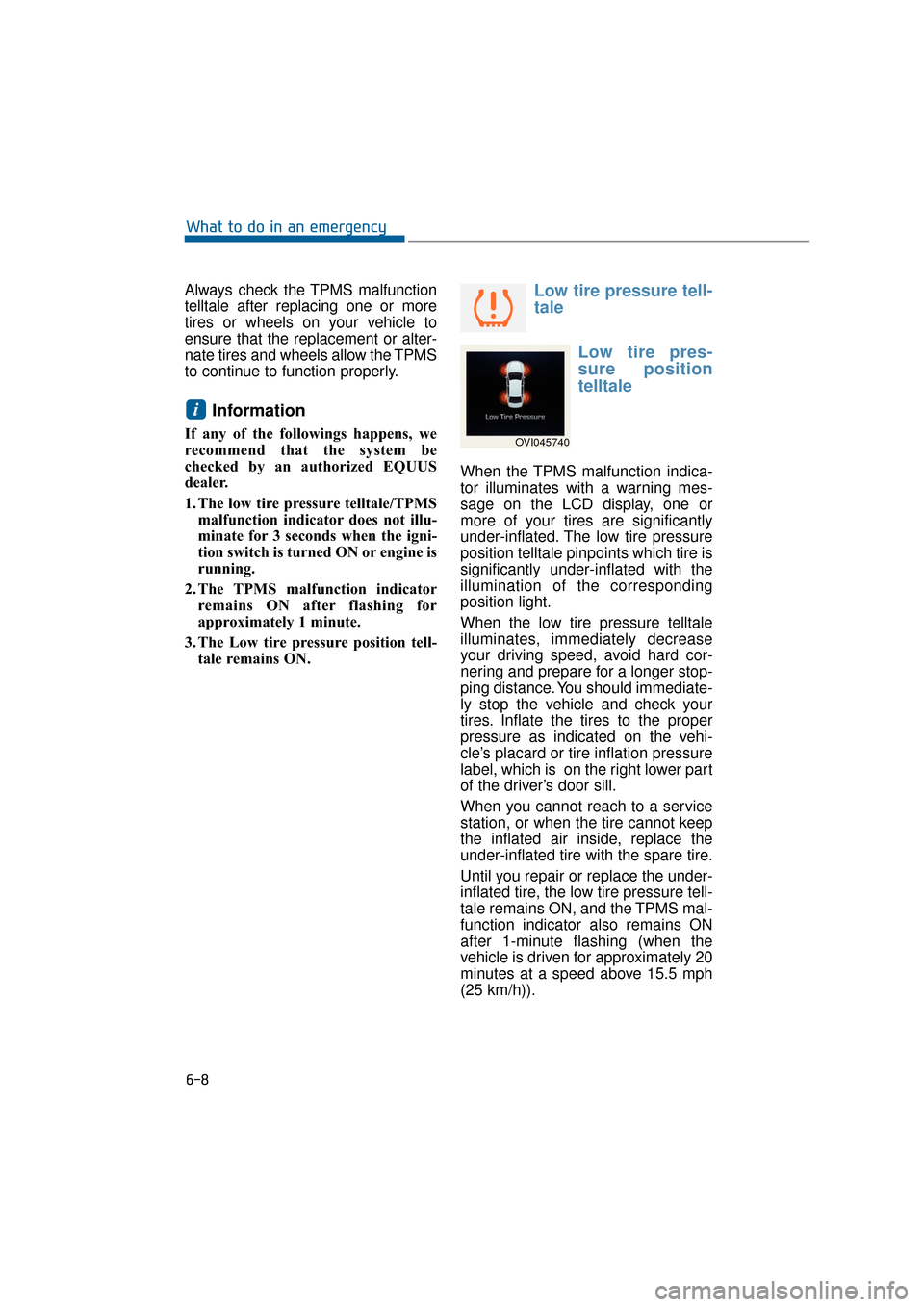
Always check the TPMS malfunction
telltale after replacing one or more
tires or wheels on your vehicle to
ensure that the replacement or alter-
nate tires and wheels allow the TPMS
to continue to function properly.
Information
If any of the followings happens, we
recommend that the system be
checked by an authorized EQUUS
dealer.
1. The low tire pressure telltale/TPMSmalfunction indicator does not illu-
minate for 3 seconds when the igni-
tion switch is turned ON or engine is
running.
2. The TPMS malfunction indicator remains ON after flashing for
approximately 1 minute.
3. The Low tire pressure position tell- tale remains ON.
Low tire pressure tell-
tale
Low tire pres-
sure position
telltale
When the TPMS malfunction indica-
tor illuminates with a warning mes-
sage on the LCD display, one or
more of your tires are significantly
under-inflated. The low tire pressure
position telltale pinpoints which tire is
significantly under-inflated with the
illumination of the corresponding
position light.
When the low tire pressure telltale
illuminates, immediately decrease
your driving speed, avoid hard cor-
nering and prepare for a longer stop-
ping distance. You should immediate-
ly stop the vehicle and check your
tires. Inflate the tires to the proper
pressure as indicated on the vehi-
cle’s placard or tire inflation pressure
label, which is on the right lower part
of the driver’s door sill.
When you cannot reach to a service
station, or when the tire cannot keep
the inflated air inside, replace the
under-inflated tire with the spare tire.
Until you repair or replace the under-
inflated tire, the low tire pressure tell-
tale remains ON, and the TPMS mal-
function indicator also remains ON
after 1-minute flashing (when the
vehicle is driven for approximately 20
minutes at a speed above 15.5 mph
(25 km/h)).
i
6-8
What to do in an emergency
OVI045740
Page 342 of 477
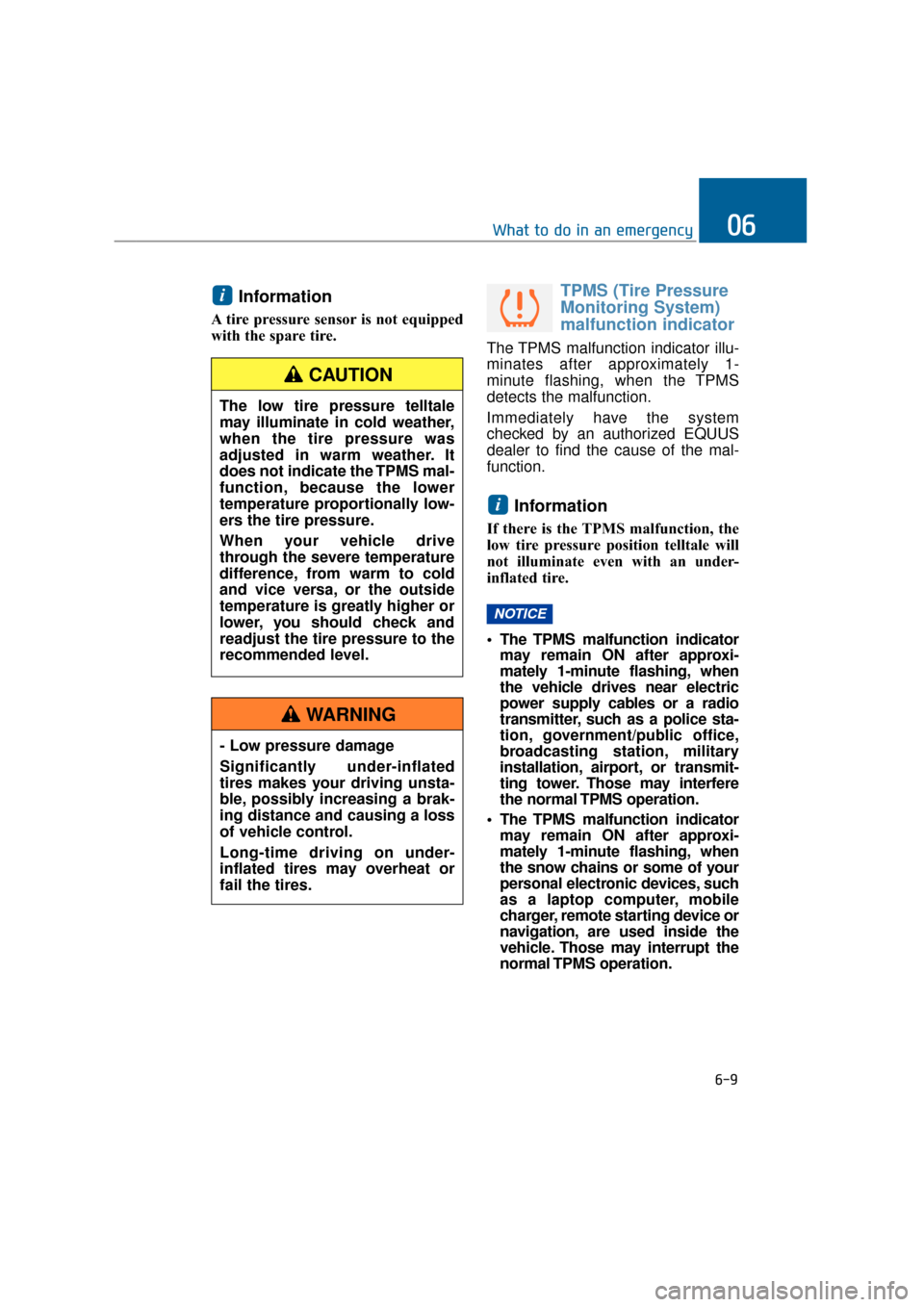
Information
A tire pressure sensor is not equipped
with the spare tire.
TPMS (Tire Pressure
Monitoring System)
malfunction indicator
The TPMS malfunction indicator illu-
minates after approximately 1-
minute flashing, when the TPMS
detects the malfunction.
Immediately have the system
checked by an authorized EQUUS
dealer to find the cause of the mal-
function.
Information
If there is the TPMS malfunction, the
low tire pressure position telltale will
not illuminate even with an under-
inflated tire.
The TPMS malfunction indicatormay remain ON after approxi-
mately 1-minute flashing, when
the vehicle drives near electric
power supply cables or a radio
transmitter, such as a police sta-
tion, government/public office,
broadcasting station, military
installation, airport, or transmit-
ting tower. Those may interfere
the normal TPMS operation.
The TPMS malfunction indicator may remain ON after approxi-
mately 1-minute flashing, when
the snow chains or some of your
personal electronic devices, such
as a laptop computer, mobile
charger, remote starting device or
navigation, are used inside the
vehicle. Those may interrupt the
normal TPMS operation.
NOTICE
i
i
6-9
What to do in an emergency06
The low tire pressure telltale
may illuminate in cold weather,
when the tire pressure was
adjusted in warm weather. It
does not indicate the TPMS mal-
function, because the lower
temperature proportionally low-
ers the tire pressure.
When your vehicle drive
through the severe temperature
difference, from warm to cold
and vice versa, or the outside
temperature is greatly higher or
lower, you should check and
readjust the tire pressure to the
recommended level.
CAUTION
- Low pressure damage
Significantly under-inflated
tires makes your driving unsta-
ble, possibly increasing a brak-
ing distance and causing a loss
of vehicle control.
Long-time driving on under-
inflated tires may overheat or
fail the tires.
WARNING
Page 343 of 477
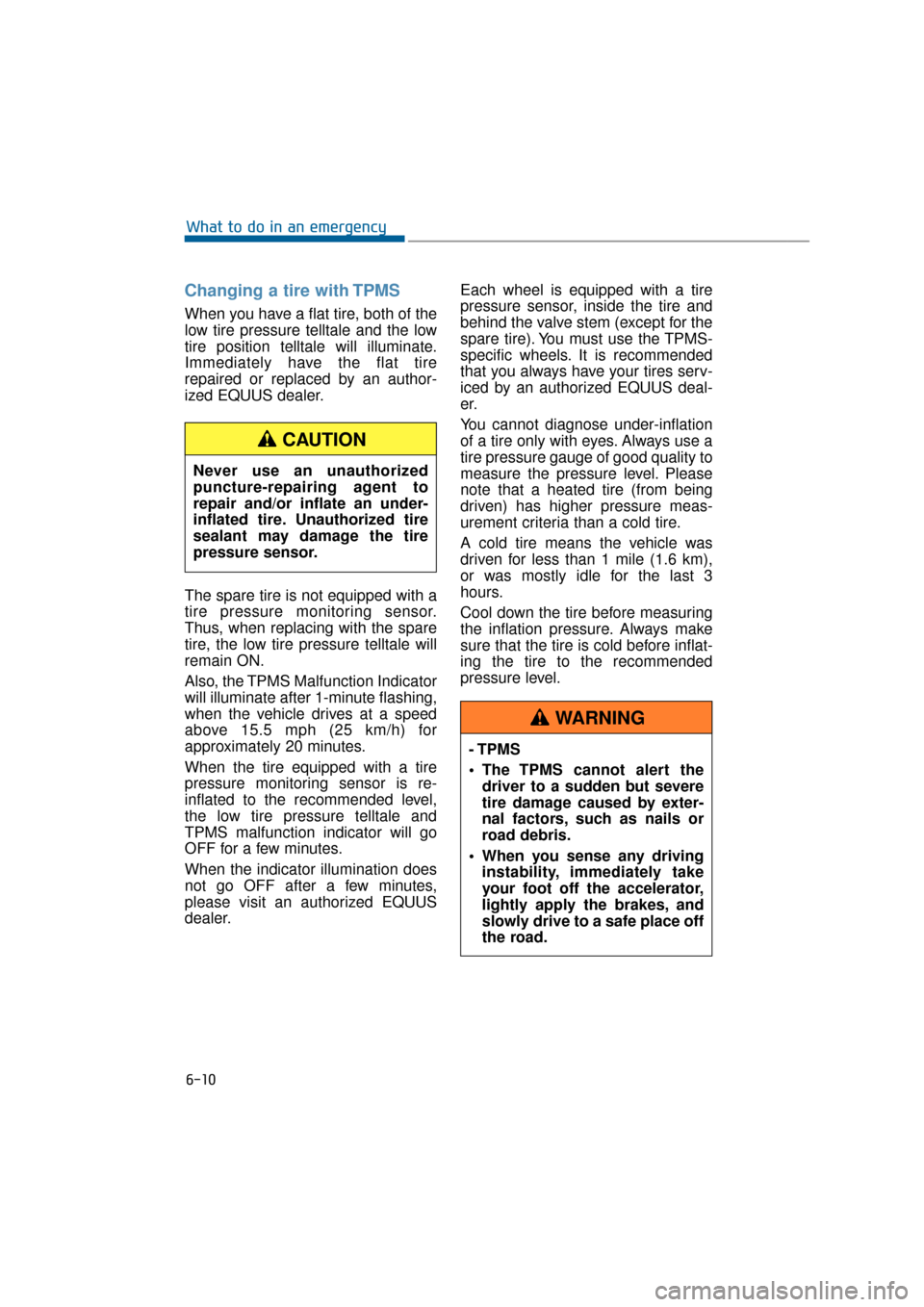
Changing a tire with TPMS
When you have a flat tire, both of the
low tire pressure telltale and the low
tire position telltale will illuminate.
Immediately have the flat tire
repaired or replaced by an author-
ized EQUUS dealer.
The spare tire is not equipped with a
tire pressure monitoring sensor.
Thus, when replacing with the spare
tire, the low tire pressure telltale will
remain ON.
Also, the TPMS Malfunction Indicator
will illuminate after 1-minute flashing,
when the vehicle drives at a speed
above 15.5 mph (25 km/h) for
approximately 20 minutes.
When the tire equipped with a tire
pressure monitoring sensor is re-
inflated to the recommended level,
the low tire pressure telltale and
TPMS malfunction indicator will go
OFF for a few minutes.
When the indicator illumination does
not go OFF after a few minutes,
please visit an authorized EQUUS
dealer.Each wheel is equipped with a tire
pressure sensor, inside the tire and
behind the valve stem (except for the
spare tire). You must use the TPMS-
specific wheels. It is recommended
that you always have your tires serv-
iced by an authorized EQUUS deal-
er.
You cannot diagnose under-inflation
of a tire only with eyes. Always use a
tire pressure gauge of good quality to
measure the pressure level. Please
note that a heated tire (from being
driven) has higher pressure meas-
urement criteria than a cold tire.
A cold tire means the vehicle was
driven for less than 1 mile (1.6 km),
or was mostly idle for the last 3
hours.
Cool down the tire before measuring
the inflation pressure. Always make
sure that the tire is cold before inflat-
ing the tire to the recommended
pressure level.
6-10
What to do in an emergency
Never use an unauthorized
puncture-repairing agent to
repair and/or inflate an under-
inflated tire. Unauthorized tire
sealant may damage the tire
pressure sensor.
CAUTION
- TPMS
The TPMS cannot alert the driver to a sudden but severe
tire damage caused by exter-
nal factors, such as nails or
road debris.
When you sense any driving instability, immediately take
your foot off the accelerator,
lightly apply the brakes, and
slowly drive to a safe place off
the road.
WARNING
Page 344 of 477
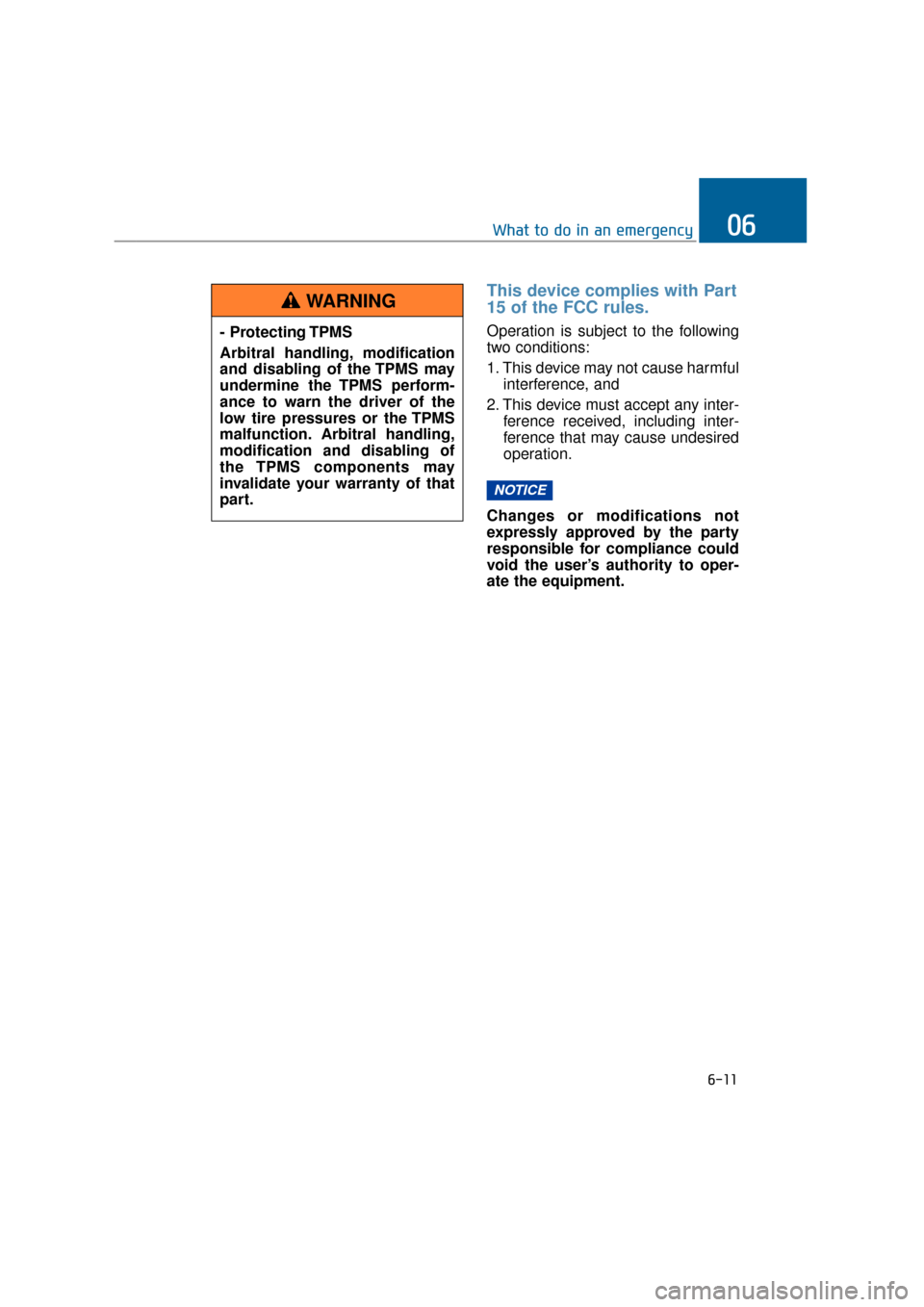
This device complies with Part
15 of the FCC rules.
Operation is subject to the following
two conditions:
1. This device may not cause harmfulinterference, and
2. This device must accept any inter- ference received, including inter-
ference that may cause undesired
operation.
Changes or modifications not
expressly approved by the party
responsible for compliance could
void the user’s authority to oper-
ate the equipment.
NOTICE
6-11
What to do in an emergency06
- Protecting TPMS
Arbitral handling, modification
and disabling of the TPMS may
undermine the TPMS perform-
ance to warn the driver of the
low tire pressures or the TPMS
malfunction. Arbitral handling,
modification and disabling of
the TPMS components may
invalidate your warranty of that
part.
WARNING
Page 345 of 477

Jack and tools
The jack, jack handle, and wheel lug
nut wrench are stored in the luggage
compartment. Pull up the luggage
box cover to find those equipment.
(1) Jack handle
(2) Jack
(3) Wheel lug nut wrench
Jacking instructions
The jack is provided for emergent tire
changing only.
To prevent the jack from “rattling”
inside while driving, store it properly.
Follow jacking instructions to prevent
a possible personal injury.
I IF
F
Y
Y O
O U
U
H
H A
AV
VE
E
A
A
F
F L
LA
A T
T
T
T I
IR
R E
E
6-12
What to do in an emergency
OVI065004N
- Changing tires
Never attempt to change tires
in the traffic lanes of a road or
highway.
Always drive the vehicle com- pletely off the road or onto the
shoulder before changing a
tire. The jack should be used
on a level and firm ground.
When you cannot find this
level and firm place off the
road, call a towing service
company for assistance.
Always check the jack direc- tion - in the correct front and
rear positions. Never use the
bumper or any other parts of
the vehicle for additional jack-
ing-up support.
The vehicle may roll off the jack, causing a serious injury
or death. Never place any part
of a person's body under-
neath a vehicle, while jacking
up the vehicle; use vehicle
support stands.
Do not start or run the engine, while jacking up the vehicle.
Do not allow anyone to remain inside, while jacking up the
vehicle.
Keep all children in a safe place away from the road and
from the vehicle to be jacked
up.
WARNING
Page 346 of 477
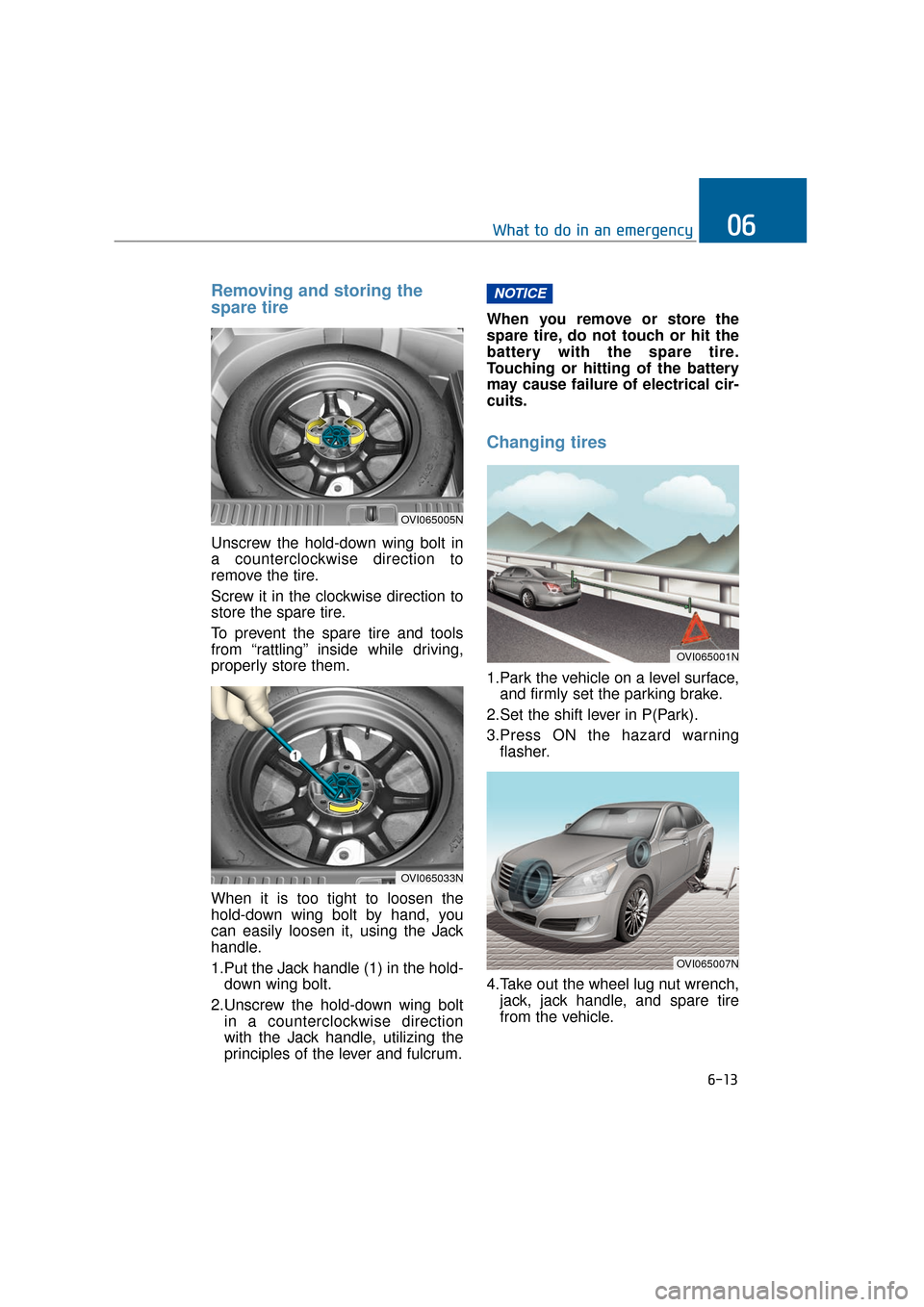
Removing and storing the
spare tire
Unscrew the hold-down wing bolt in
a counterclockwise direction to
remove the tire.
Screw it in the clockwise direction to
store the spare tire.
To prevent the spare tire and tools
from “rattling” inside while driving,
properly store them.
When it is too tight to loosen the
hold-down wing bolt by hand, you
can easily loosen it, using the Jack
handle.
1.Put the Jack handle (1) in the hold-down wing bolt.
2.Unscrew the hold-down wing bolt in a counterclockwise direction
with the Jack handle, utilizing the
principles of the lever and fulcrum. When you remove or store the
spare tire, do not touch or hit the
battery with the spare tire.
Touching or hitting of the battery
may cause failure of electrical cir-
cuits.
Changing tires
1.Park the vehicle on a level surface,
and firmly set the parking brake.
2.Set the shift lever in P(Park).
3.Press ON the hazard warning flasher.
4.Take out the wheel lug nut wrench, jack, jack handle, and spare tire
from the vehicle.
NOTICE
6-13
What to do in an emergency06
OVI065005N
OVI065033N
OVI065001N
OVI065007N
Page 347 of 477
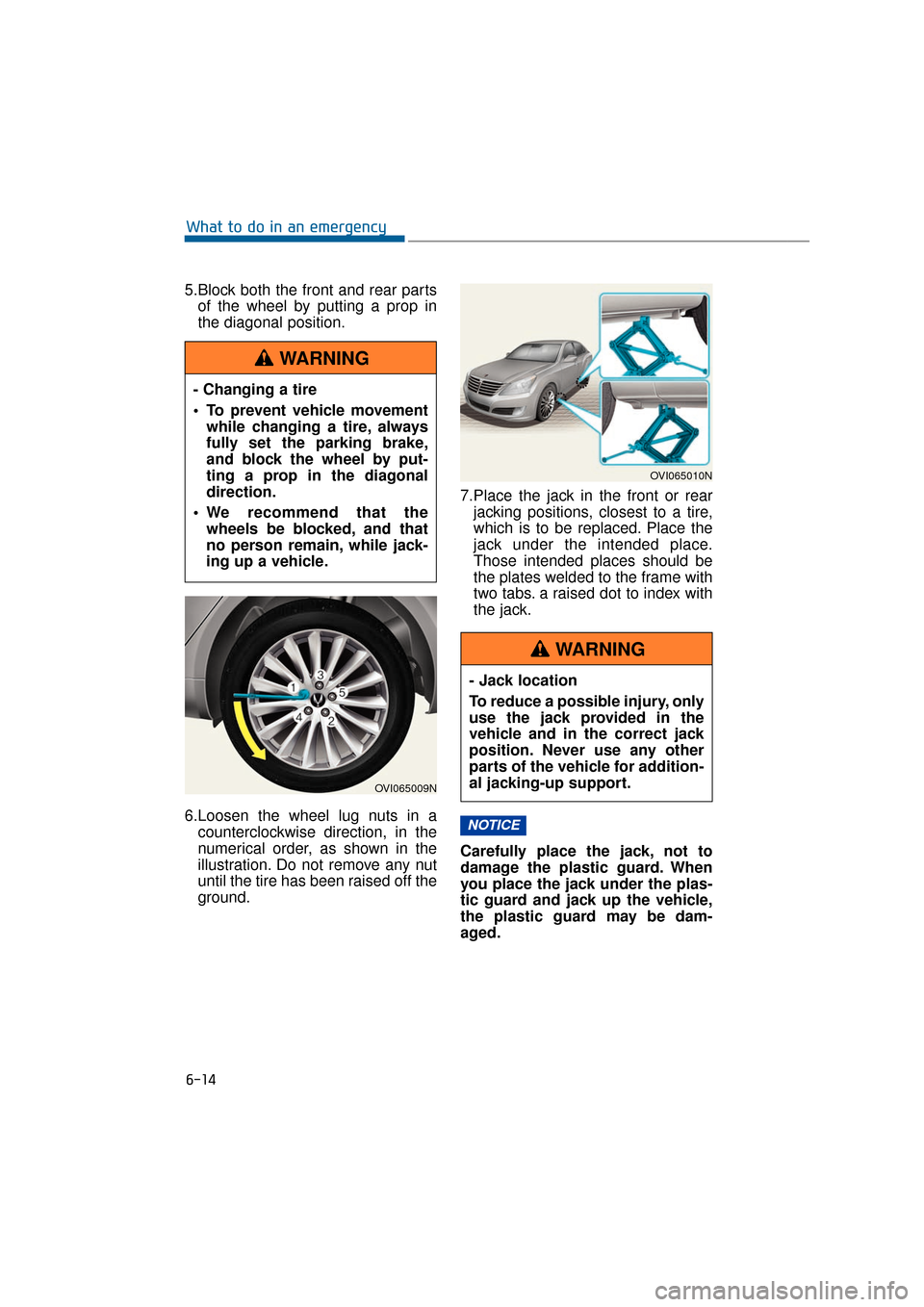
5.Block both the front and rear partsof the wheel by putting a prop in
the diagonal position.
6.Loosen the wheel lug nuts in a counterclockwise direction, in the
numerical order, as shown in the
illustration. Do not remove any nut
until the tire has been raised off the
ground. 7.Place the jack in the front or rear
jacking positions, closest to a tire,
which is to be replaced. Place the
jack under the intended place.
Those intended places should be
the plates welded to the frame with
two tabs. a raised dot to index with
the jack.
Carefully place the jack, not to
damage the plastic guard. When
you place the jack under the plas-
tic guard and jack up the vehicle,
the plastic guard may be dam-
aged.
NOTICE
6-14
What to do in an emergency - Changing a tire
To prevent vehicle movement while changing a tire, always
fully set the parking brake,
and block the wheel by put-
ting a prop in the diagonal
direction.
We recommend that the wheels be blocked, and that
no person remain, while jack-
ing up a vehicle.
WARNING
- Jack location
To reduce a possible injury, only
use the jack provided in the
vehicle and in the correct jack
position. Never use any other
parts of the vehicle for addition-
al jacking-up support.
WARNING
OVI065009N
OVI065010N
Page 348 of 477
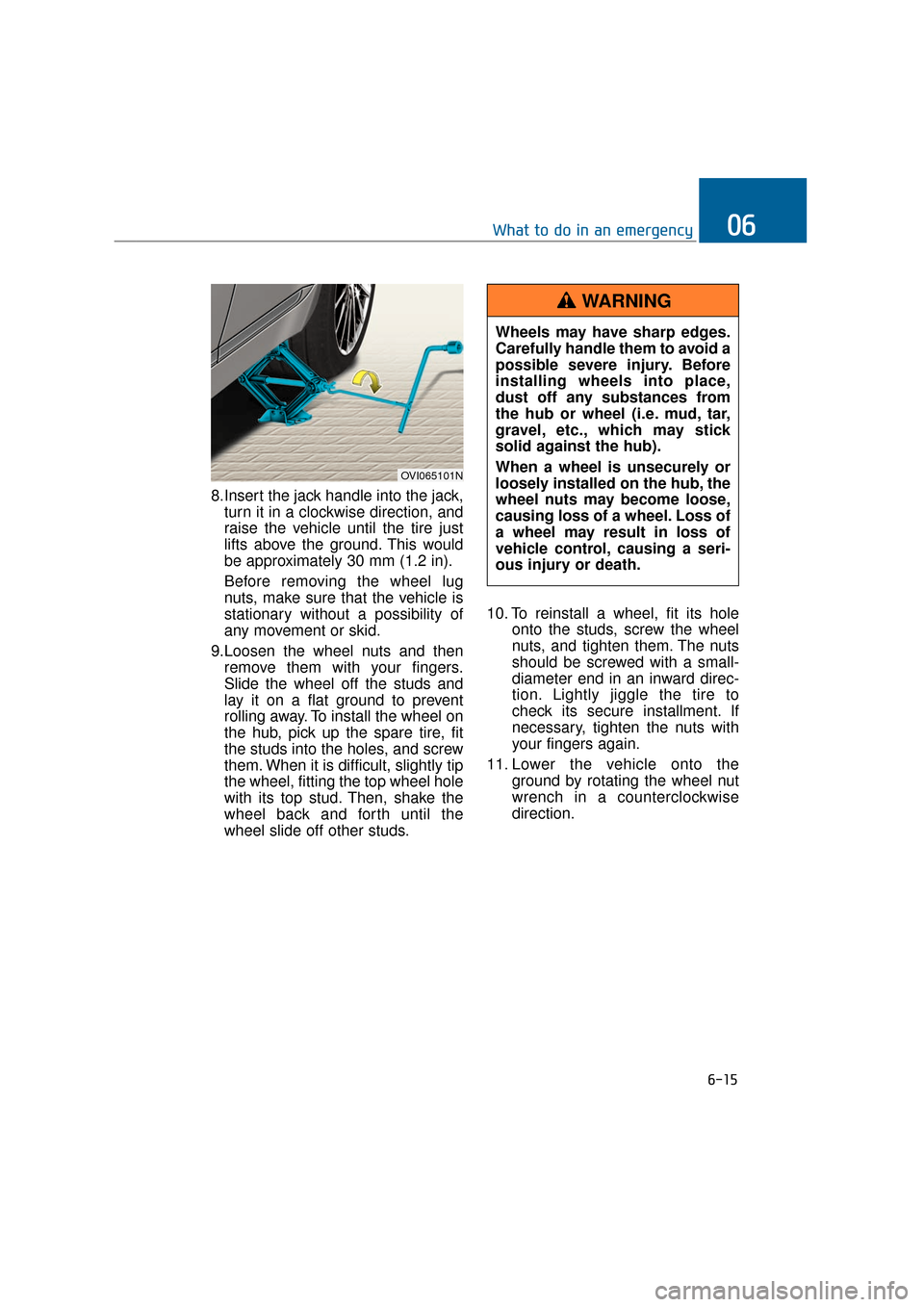
8.Insert the jack handle into the jack,turn it in a clockwise direction, and
raise the vehicle until the tire just
lifts above the ground. This would
be approximately 30 mm (1.2 in).
Before removing the wheel lug
nuts, make sure that the vehicle is
stationary without a possibility of
any movement or skid.
9.Loosen the wheel nuts and then remove them with your fingers.
Slide the wheel off the studs and
lay it on a flat ground to prevent
rolling away. To install the wheel on
the hub, pick up the spare tire, fit
the studs into the holes, and screw
them. When it is difficult, slightly tip
the wheel, fitting the top wheel hole
with its top stud. Then, shake the
wheel back and forth until the
wheel slide off other studs. 10. To reinstall a wheel, fit its hole
onto the studs, screw the wheel
nuts, and tighten them. The nuts
should be screwed with a small-
diameter end in an inward direc-
tion. Lightly jiggle the tire to
check its secure installment. If
necessary, tighten the nuts with
your fingers again.
11. Lower the vehicle onto the ground by rotating the wheel nut
wrench in a counterclockwise
direction.
6-15
What to do in an emergency06
Wheels may have sharp edges.
Carefully handle them to avoid a
possible severe injury. Before
installing wheels into place,
dust off any substances from
the hub or wheel (i.e. mud, tar,
gravel, etc., which may stick
solid against the hub).
When a wheel is unsecurely or
loosely installed on the hub, the
wheel nuts may become loose,
causing loss of a wheel. Loss of
a wheel may result in loss of
vehicle control, causing a seri-
ous injury or death.
WARNING
OVI065101N
Page 349 of 477
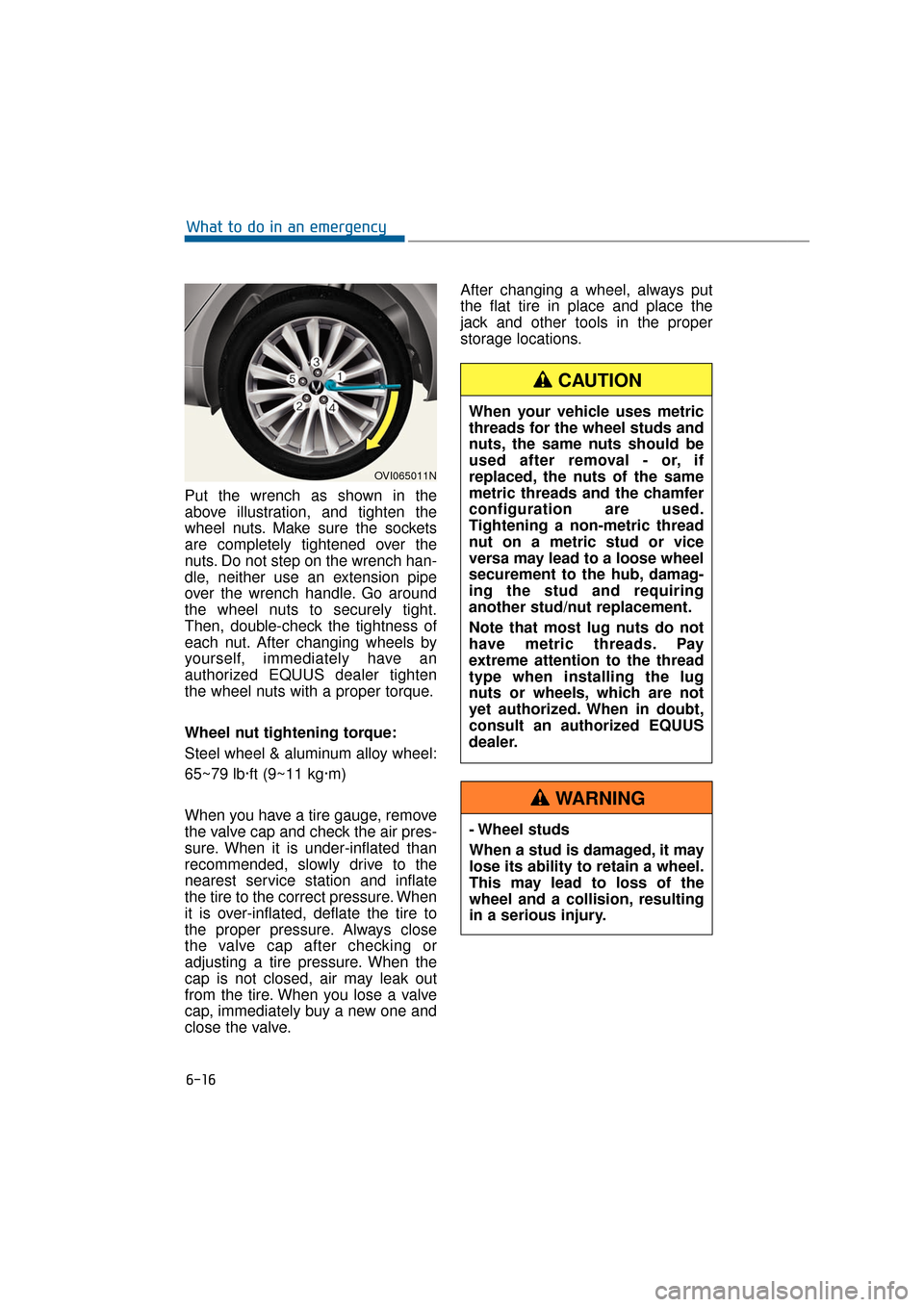
Put the wrench as shown in the
above illustration, and tighten the
wheel nuts. Make sure the sockets
are completely tightened over the
nuts. Do not step on the wrench han-
dle, neither use an extension pipe
over the wrench handle. Go around
the wheel nuts to securely tight.
Then, double-check the tightness of
each nut. After changing wheels by
yourself, immediately have an
authorized EQUUS dealer tighten
the wheel nuts with a proper torque.
Wheel nut tightening torque:
Steel wheel & aluminum alloy wheel:
65~79 lb·ft (9~11 kg·m)
When you have a tire gauge, remove
the valve cap and check the air pres-
sure. When it is under-inflated than
recommended, slowly drive to the
nearest service station and inflate
the tire to the correct pressure. When
it is over-inflated, deflate the tire to
the proper pressure. Always close
the valve cap after checking or
adjusting a tire pressure. When the
cap is not closed, air may leak out
from the tire. When you lose a valve
cap, immediately buy a new one and
close the valve.After changing a wheel, always put
the flat tire in place and place the
jack and other tools in the proper
storage locations.
6-16
What to do in an emergency
OVI065011N
When your vehicle uses metric
threads for the wheel studs and
nuts, the same nuts should be
used after removal - or, if
replaced, the nuts of the same
metric threads and the chamfer
configuration are used.
Tightening a non-metric thread
nut on a metric stud or vice
versa may lead to a loose wheel
securement to the hub, damag-
ing the stud and requiring
another stud/nut replacement.
Note that most lug nuts do not
have metric threads. Pay
extreme attention to the thread
type when installing the lug
nuts or wheels, which are not
yet authorized. When in doubt,
consult an authorized EQUUS
dealer.
CAUTION
- Wheel studs
When a stud is damaged, it may
lose its ability to retain a wheel.
This may lead to loss of the
wheel and a collision, resulting
in a serious injury.
WARNING
Page 350 of 477
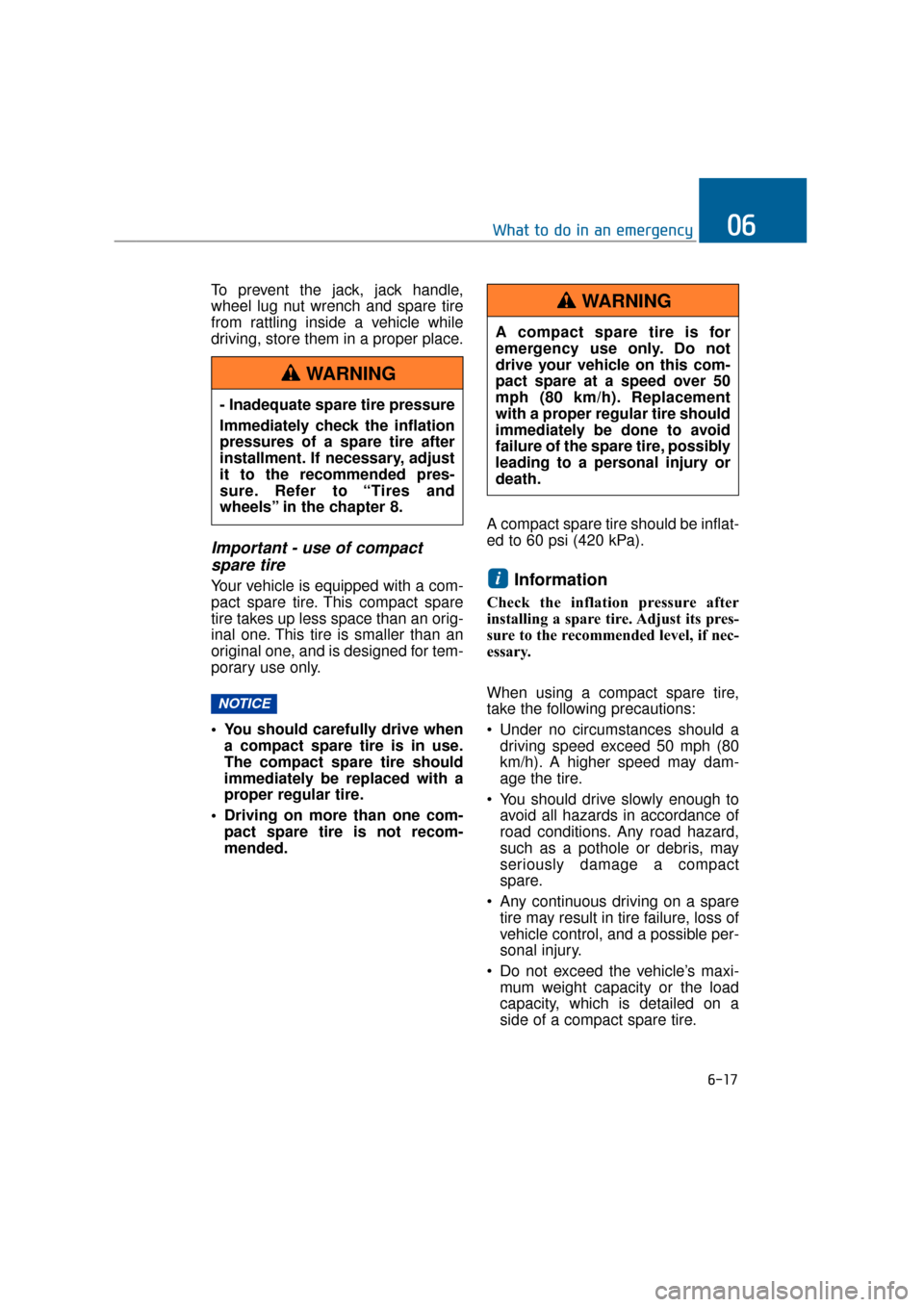
To prevent the jack, jack handle,
wheel lug nut wrench and spare tire
from rattling inside a vehicle while
driving, store them in a proper place.
Important - use of compactspare tire
Your vehicle is equipped with a com-
pact spare tire. This compact spare
tire takes up less space than an orig-
inal one. This tire is smaller than an
original one, and is designed for tem-
porary use only.
You should carefully drive when
a compact spare tire is in use.
The compact spare tire should
immediately be replaced with a
proper regular tire.
Driving on more than one com- pact spare tire is not recom-
mended. A compact spare tire should be inflat-
ed to 60 psi (420 kPa).Information
Check the inflation pressure after
installing a spare tire. Adjust its pres-
sure to the recommended level, if nec-
essary.
When using a compact spare tire,
take the following precautions:
Under no circumstances should a
driving speed exceed 50 mph (80
km/h). A higher speed may dam-
age the tire.
You should drive slowly enough to avoid all hazards in accordance of
road conditions. Any road hazard,
such as a pothole or debris, may
seriously damage a compact
spare.
Any continuous driving on a spare tire may result in tire failure, loss of
vehicle control, and a possible per-
sonal injury.
Do not exceed the vehicle’s maxi- mum weight capacity or the load
capacity, which is detailed on a
side of a compact spare tire.
i
NOTICE
6-17
What to do in an emergency06
- Inadequate spare tire pressure
Immediately check the inflation
pressures of a spare tire after
installment. If necessary, adjust
it to the recommended pres-
sure. Refer to “Tires and
wheels” in the chapter 8.
WARNING
A compact spare tire is for
emergency use only. Do not
drive your vehicle on this com-
pact spare at a speed over 50
mph (80 km/h). Replacement
with a proper regular tire should
immediately be done to avoid
failure of the spare tire, possibly
leading to a personal injury or
death.
WARNING